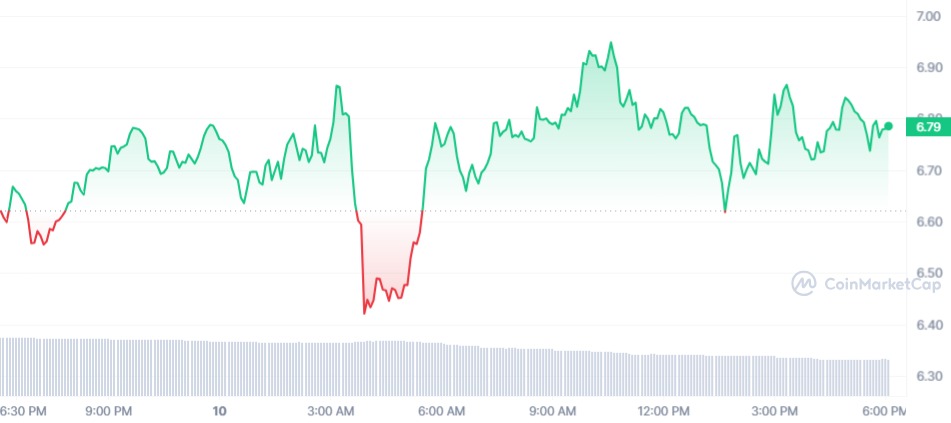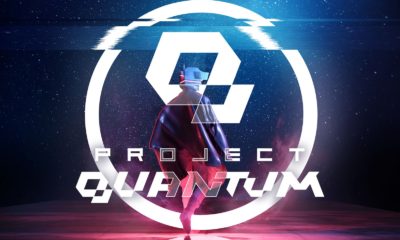Crypto
TON Cryptocurrency Value Soars: New Project Challenges Worldcoin

TON cryptocurrency is surging, driven by its innovative approach to digital identity verification, potential integration with a major stablecoin, and increasing real-world use within the Telegram ecosystem.
TON’s focus on solving practical challenges makes it a compelling project in the ever-evolving cryptocurrency landscape.
Let’s explore the factors propelling TON’s growth.
What is TON Cryptocurrency?
TON Cryptocurrency (TON Coin – The Open Network) is a decentralized blockchain known for its speed, scalability, and ability to handle large-scale applications.
It was initially a Telegram project but later adopted by an independent developer community.
Toncoin (TON), the network’s native cryptocurrency, facilitates transactions and empowers users within the ecosystem, and its recent surge in growth highlights the project’s potential.
Why is TON’s Price Surging?

Toncoin (TON) has experienced a remarkable price surge, attracting the attention of investors and cryptocurrency enthusiasts alike.
Several factors appear to be driving this growth:
- New Human Identity Validation Project: TON is launching a project to validate human identities through biometric data. It immediately competes with Worldcoin, the current leader in blockchain-based digital identity solutions, by authenticating real-world identities on the blockchain. The cryptocurrency aims to increase trust and security while decreasing bot activity on the network.
- Potential USDT Integration: The possible direct integration of Tether’s USDT stablecoin into the TON network could substantially increase the utility and demand for TON. Stablecoins, pegged to traditional currencies like the US dollar, provide stability in the volatile cryptocurrency market. Their integration often leads to price surges.
- Telegram’s Exclusive Use of TON: Telegram’s recent announcement that TON will be the sole payment method for its advertising platform further increases adoption and demand for cryptocurrency within the large Telegram community. This real-world use case drives demand and showcases TON’s practicality.
TON Takes on Worldcoin in Digital Identity
In the realm of digital identity on the blockchain, Worldcoin has emerged as the dominant player.
TON Society, a blockchain offshoot of the Telegram app, is launching its blockchain identity verification system in partnership with HumanCode, a company specializing in digital identity.
Using palm recognition technology and focusing on privacy, TON aims to onboard 500 million Telegram users in five years.
TON allocated $5 million in incentives to launch this digital verification system at the Hong Kong Web3 Festival in April 2024.
Why Digital Identity Matters on Blockchain
While blockchain networks are praised for their security and potential for anonymity, these features also present challenges.
- Trust and Verification: Identifying and verifying the parties involved in transactions can be difficult, creating potential risks. Digital identities allow for trust in transactions, even with some level of anonymity. Parties can confirm each other’s identities without needing all personal details.
- Combating Bots and Fraud: The pseudonymous nature of some blockchain users can lead to increased bot traffic. By verifying real human users, digital identity solutions can help networks combat bots and reduce fraudulent activity.
Worldcoin’s Approach, TON’s Challenge, and Concerns
Worldcoin aimed to tackle identity verification by using iris scans as biometric data. They believed biometric data provides a more reliable and fraud-resistant form of identification than traditional methods like usernames and passwords.
By creating a “proof of personhood,” Worldcoin intended to link each digital identity to a unique human being.
TON takes a similar approach but utilizes palm scans instead, aiming for a more user-friendly and privacy-focused solution.
Despite assurances from both organizations, the use of biometric data raises serious privacy concerns for many, and Worldcoin’s major security breach, potentially putting user data at risk, highlights these concerns.
TON’s Future Outlook
These exciting developments, coupled with Telegram’s adoption of TON, position the cryptocurrency for continued growth.
While the potential integration of USDT remains speculative, its realization could trigger another significant surge in TON’s value.
The competition with Worldcoin in the digital identity space will be a fascinating area to watch.
Conclusion
TON cryptocurrency’s recent momentum highlights its potential for further growth and adoption.
Its commitment to innovation, focus on real-world problems, and integration within the Telegram ecosystem make TON a project to keep a close eye on in the ever-evolving cryptocurrency landscape.
While the current surge is exciting, it’s essential to remember that cryptocurrency markets can be volatile. Thorough research and a balanced understanding of potential risks are crucial before making any investment decisions.
Crypto
Vitalik Buterin Offloads STRAYDOG as Team Initiates Buybacks and Strategic Token Burn Plan

Ethereum founder Vitalik Buterin sold STRAYDOG tokens over the past twenty four hours according to on chain data. The tokens were originally received via airdrop from community and team nearly four months ago.
The sale occurred near recent price lows during a broader period of market weakness. Similar sales by Buterin in past cycles have often coincided with shifts in market attention rather than extended downside.
Following the transaction STRAYDOG team began purchasing tokens on the open market. The team confirmed that purchased tokens will be allocated toward a future burn.
According to the team two hundred thousand dollars worth of bought STRAYDOG tokens will be burned once the token reaches a ten million dollar market capitalization reducing circulating supply.
Market participants are now watching on chain activity as the project approaches the announced milestone.
The project maintains a fat treasury valued at hundreds of thousand of dollars, enabling the development team to continue conducting ongoing buybacks rather than a one time purchase. The team also stated that it plans to burn $200,000 worth of bought STRAYDOG tokens at every additional $10 million increase in market capitalization, further reducing circulating supply over time.
Telegram – t.me/StrayDogETH
Website –www.straydogcoin.com
Book on amazon –https://a.co/d/3nzCtUp
Crypto
Marshall Islands Turn to Digital Assets to Expand Financial Access

The Republic of the Marshall Islands is taking a major step toward digital transformation, piloting a blockchain-based system to distribute universal basic income (UBI). The initiative aims to reduce the nation’s dependence on physical cash and address long-standing financial access issues across its remote island communities.
A move from paper checks to digital wallets
During the latest payout cycle, Marshallese citizens received their UBI in two different ways. Some continued using traditional paper checks issued through the Economic and Natural Resources Authority. Others, however, received funds digitally through Lomalo, a citizen wallet built on the Stellar blockchain.
The digital payments were delivered in USDM1, a government-designed token intended to act as a sovereign financial instrument rather than a typical stablecoin. Unlike most stablecoins—where yield flows to the issuer—USDM1 functions similarly to a government-backed money market asset, generating returns directly for the holder.
This structure is meant to stabilize the token’s value and distance it from the volatility seen in assets such as Bitcoin, while still enabling everyday payments.
A wallet built for mass adoption
Despite improvements in internet connectivity through satellite providers such as Starlink, daily commerce in the Marshall Islands still depends heavily on physical cash. Cash shipments arrive by boat, and delays can lead to temporary shortages, limiting residents’ ability to transact or access money.
Digital delivery through Lomalo is designed to change that. Payments can be sent instantly across the islands without relying on cash deliveries or a fragile physical banking network. The wallet also strips away the typical technical complexity associated with crypto applications. Crypto infrastructure firm Crossmint manages the onboarding process, enabling citizens to use digital funds without understanding private keys or blockchain mechanics.
The broader push toward digital assets also reflects the country’s challenging financial reality. In the years following the 2008 global financial crisis, many foreign banks exited the region over compliance and risk concerns. That exodus left the Marshall Islands with just one correspondent banking partner—creating a vulnerability for everything from international transfers to local business operations.
USDM1 offers an alternative pathway by reducing reliance on traditional bank channels and giving residents an additional method to store and access funds.
Part of a wider global strategy
The Marshall Islands pilot is one component of a larger effort led by the Stellar Development Fund to expand financial access in underserved regions. The organization has allocated several million dollars to support the USDM1 initiative.
The approach builds on previous projects that facilitated humanitarian payments, including salary distributions for healthcare workers in conflict zones and cash-assistance programs run with NGOs. Lessons learned from partnerships with the Ukrainian government and international aid groups helped refine the system now being tested in the Marshall Islands.
Across all these programs, the core goal remains the same: ensuring individuals—not intermediaries—have direct control over their digital assets, while improving access to reliable financial infrastructure.
Crypto
Why Is Midnight (NIGHT) Price Pumping Hard?

The Midnight (NIGHT) price has surged to the top of the market leaderboard, jumping roughly 30% in a single session and trading around $0.0866 at the time of writing. The rally isn’t happening in isolation. Trading volume has spiked nearly 70%, signaling genuine market participation rather than a temporary liquidity anomaly. As a result, the NIGHT token has become one of the day’s strongest performers, attracting attention both inside and beyond Cardano’s ecosystem.
A mix of partnership speculation, regulatory narratives, and a clean technical breakout is driving the current Midnight price momentum and helping push the asset into a new phase of price discovery.
A key catalyst behind the Midnight price pump is rising speculation about a potential stablecoin partnership. Midnight Foundation President Fahmi Syed confirmed that the team has received a legal contract from a prospective partner—an indication that talks have moved past preliminary stages. For traders, this was enough to begin pricing in the possibility of compliant stablecoin infrastructure built directly on Midnight’s privacy-focused network.
Given how central stablecoins are to liquidity, payments, and on-chain activity, the idea of a regulated privacy chain supporting compliant stablecoin integrations has fueled bullish sentiment around the NIGHT token.
Regulatory dynamics in the EU are adding further weight to the rally. New proposals targeting anonymous transactions and digital identity verification have renewed interest in privacy solutions built for regulated environments. Midnight’s selective disclosure model—which enables verification without exposing full personal data—positions it as a potential middle ground between transparent blockchains and traditional privacy coins.
While regulatory frameworks remain in flux, the environment favors projects that can offer compliance-ready privacy. For now, the Midnight crypto narrative fits that trend.
The surge in NIGHT trading activity shows the rally is not merely social-media driven. At one point, Midnight ranked among the top five assets globally by trading volume, a signal that demand is broad instead of concentrated in a single community. Sustaining high volume will be essential if the recent price move is to evolve into a longer-term trend. Sharp increases without follow-through often lead to quick reversals or sideways consolidation.
On the technical front, the Midnight price has delivered a clean breakout. On the 1-hour chart, NIGHT pushed above its long-standing consolidation band between $0.060 and $0.065, a range that repeatedly capped upside attempts. The breakout happened on rising volume—a strong confirmation signal—and the chart has since produced a series of higher highs and higher lows.
Analytics platform TapTools described the current phase as “entering price discovery,” reflecting the lack of historical resistance overhead. With no clear prior supply zones, movement is now primarily driven by momentum, trader positioning, and incoming news flows.
From a structural perspective, the key support level to watch is the former breakout zone around $0.070. As long as the Midnight price stays above that threshold, short-term momentum remains strongly bullish. Losing that level could open the door to consolidation or a retest of lower support, especially if trading volume begins to fade.
In the short term, upside continuation for the NIGHT token depends heavily on whether volume remains elevated and whether the rumored partnership developments gain clarity. If the Midnight Foundation confirms progress on compliant stablecoin integrations—or offers new ecosystem updates—traders may continue to position aggressively around the narrative.
For now, the Midnight (NIGHT) price pump reflects a convergence of strong catalysts: a promising potential partnership, favorable regulatory positioning for privacy technologies, and a decisive technical breakout. Together, these forces explain why Midnight is suddenly capturing market attention and why many traders are watching closely to see whether this surge marks the beginning of a larger trend.
-

 Crypto3 years ago
Crypto3 years agoCardalonia Aiming To Become The Biggest Metaverse Project On Cardano
-

 Press Release5 years ago
Press Release5 years agoP2P2C BREAKTHROUGH CREATES A CONNECTION BETWEEN ETM TOKEN AND THE SUPER PROFITABLE MARKET
-

 Blockchain5 years ago
Blockchain5 years agoWOM Protocol partners with CoinPayments, the world’s largest cryptocurrency payments processor
-

 Press Release5 years ago
Press Release5 years agoETHERSMART DEVELOPER’S VISION MADE FINTECH COMPANY BECOME DUBAI’S TOP DIGITAL BANK
-

 Press Release5 years ago
Press Release5 years agoProject Quantum – Decentralised AAA Gaming
-

 Blockchain5 years ago
Blockchain5 years agoWOM Protocol Recommended by Premier Crypto Analyst as only full featured project for August
-

 Press Release5 years ago
Press Release5 years agoETHERSMART DEVELOPER’S VISION MADE FINTECH COMPANY BECOME DUBAI’S TOP DIGITAL BANK
-

 Blockchain6 years ago
Blockchain6 years ago1.5 Times More Bitcoin is purchased by Grayscale Than Daily Mined Coins






